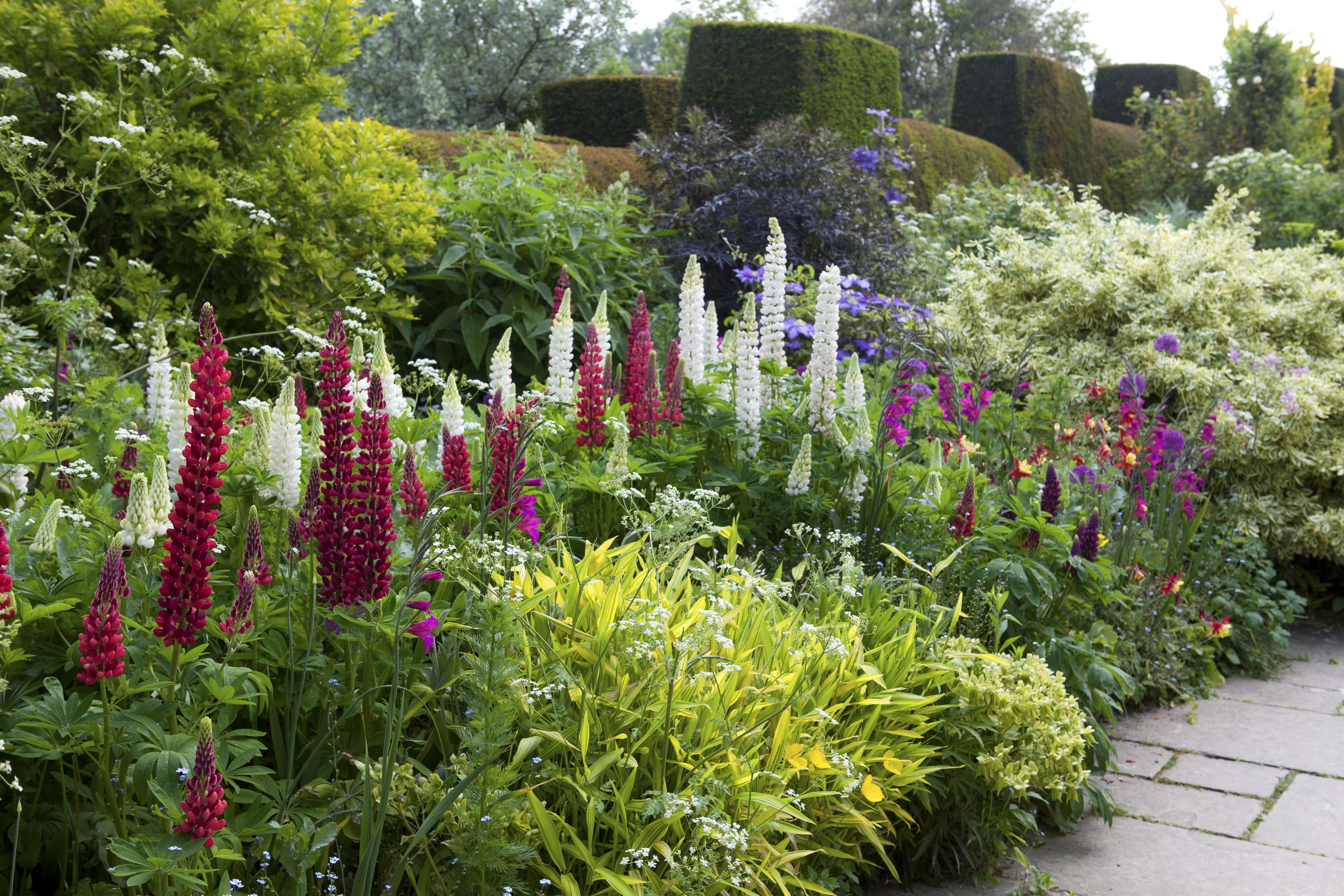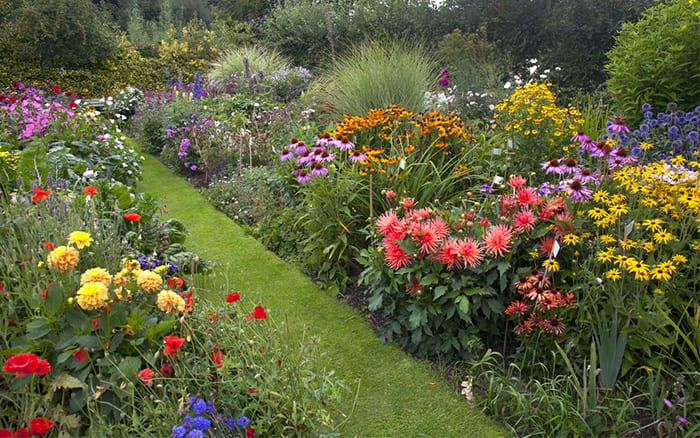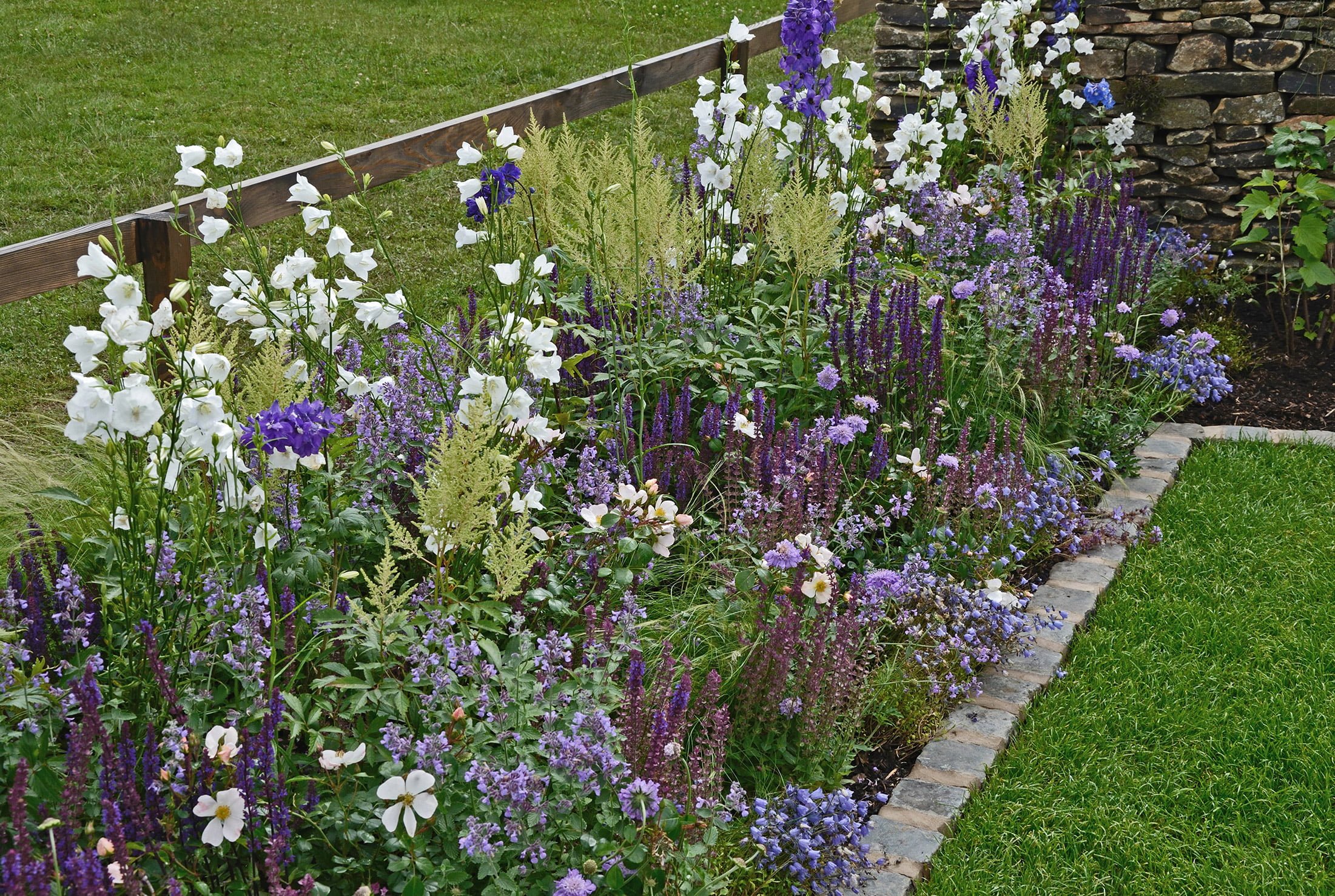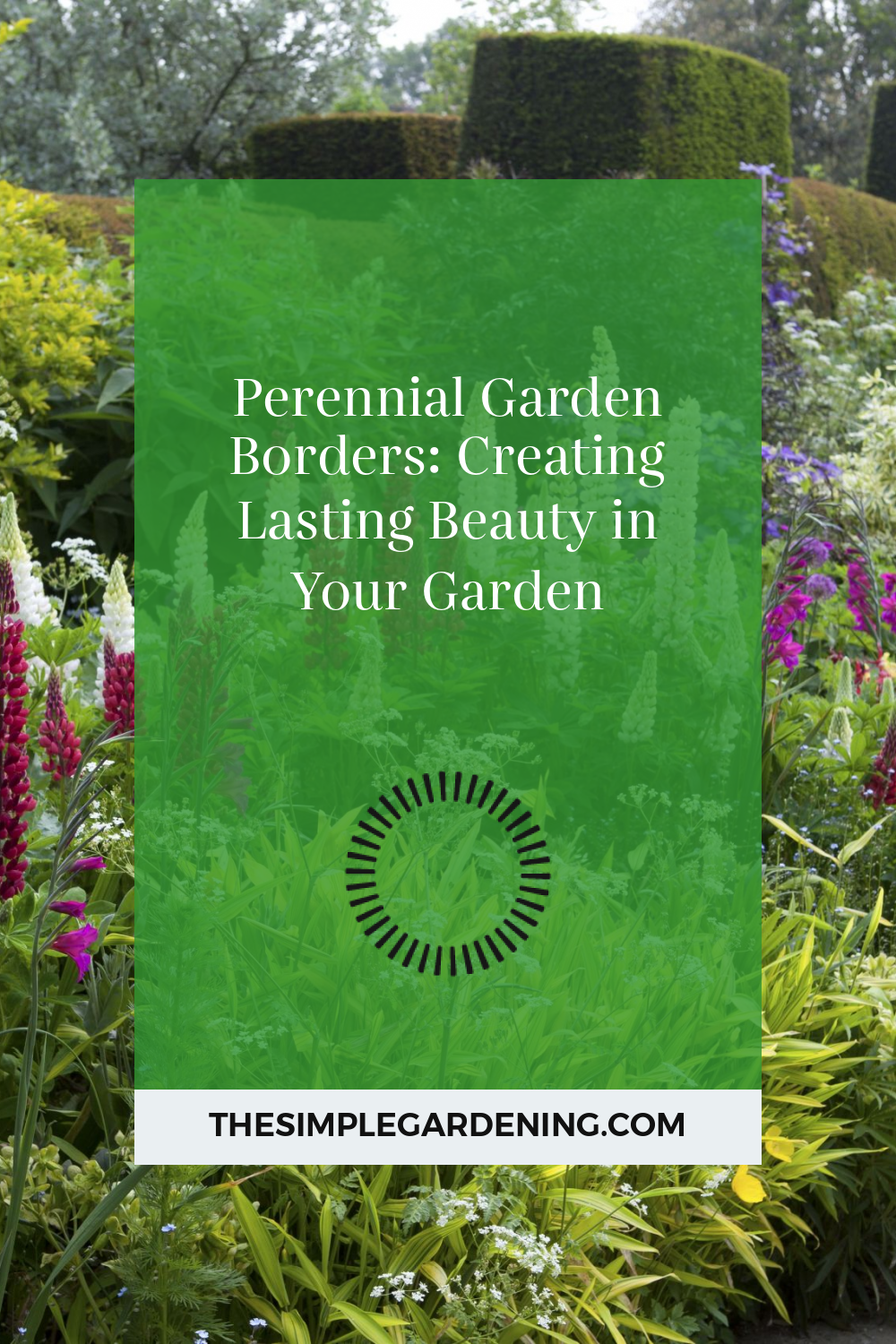Perennial garden borders are a timeless feature in any garden. These planting schemes use perennial plants, which live for more than two years, to create attractive and lasting edges that offer beauty and interest year after year. Let’s delve into the many facets of creating and maintaining perennial garden borders.
What are Perennial Garden Borders?
Perennial garden borders are specifically designed planting arrangements using perennial plants. These plants return each year, reducing the need for replanting and offering continuous beauty.
Table: Key Benefits of Perennial Garden Borders
| Benefit | Description |
|---|---|
| Longevity | Perennials live for multiple years, reducing the need for replanting. |
| Reduced Maintenance | Once established, perennials require less care than annuals. |
| Seasonal Interest | They provide color and structure in different seasons. |
Historical Overview
Perennial borders have evolved significantly over time. Traditionally, they were used in formal gardens to create structure and visual interest. Over time, garden design trends have shifted towards more naturalistic and mixed planting schemes.
Table: Evolution of Perennial Garden Borders
| Period | Characteristics |
|---|---|
| Traditional | Formal, structured designs, often in grand estates |
| 20th Century | Shift towards more naturalistic and mixed plantings |
| Modern Trends | Emphasis on sustainability, native plants, and wildlife-friendly borders |
Planning Your Perennial Garden Border
Assessing Your Garden Space
Before planting, it’s crucial to assess your garden space.
Table: Factors in Assessing Garden Space
| Factor | Considerations |
|---|---|
| Size and Shape | Measure dimensions; consider the shape for design purposes |
| Soil Quality | Test pH and nutrients; amend soil as necessary |
| Existing Features | Account for trees, buildings, and other structures |
Climate and Location Considerations
Understanding your local climate and garden location helps in selecting the right plants.
Table: Climate and Location Factors
| Factor | Considerations |
|---|---|
| USDA Hardiness Zone | Determines which plants can thrive in your area |
| Sun Exposure | Full sun, partial shade, or full shade requirements |
| Microclimates | Variations within your garden, such as sheltered spots |
Design Principles
A well-designed perennial border follows basic principles of color, height, and seasonal interest.
Table: Design Principles for Perennial Borders
| Principle | Description |
|---|---|
| Color Schemes | Choose harmonious colors for a cohesive look |
| Plant Height | Arrange by height to create depth and balance |
| Seasonal Interest | Mix plants for year-round visual interest |

Source Image: www.realhomes.com
Selecting Perennial Plants
Popular Perennials for Garden Borders
Selecting the right plants is key to a successful border.
Table: Popular Perennial Choices
| Plant Name | Characteristics | Best for |
|---|---|---|
| Daylilies | Colorful, hardy | Sunny spots |
| Hostas | Shade-loving, diverse foliage | Shady areas |
| Astilbes | Feathery flowers, moisture-loving | Wet areas |
Color and Bloom Time
Planning for continuous bloom ensures your border looks great all year.
Table: Seasonal Bloom Chart
| Season | Blooming Perennials |
|---|---|
| Spring | Tulips, daffodils, peonies |
| Summer | Daylilies, coneflowers, phlox |
| Fall | Asters, sedum, chrysanthemums |
Plant Characteristics
Choosing plants with specific characteristics helps tailor your garden to your needs.
Table: Plant Characteristics
| Characteristic | Example Plants |
|---|---|
| Drought Tolerance | Lavender, Russian sage |
| Deer Resistance | Yarrow, bee balm |
| Pest Resistance | Marigolds, geraniums |
Designing Your Perennial Border
Layout and Spacing
A well-thought-out layout enhances the visual appeal and health of your garden.
Table: Garden Layout Examples
| Layout Type | Description |
|---|---|
| Straight | Formal, structured lines |
| Curved | Naturalistic, flowing lines |
| Island | Standalone, central garden feature |
Layering Plants
Layering plants by height and depth creates a lush, full look.
Table: Plant Layering
| Layer | Example Plants |
|---|---|
| Foreground | Low-growing plants (e.g., creeping thyme) |
| Midground | Medium-height plants (e.g., coreopsis) |
| Background | Tall plants (e.g., delphiniums) |
Companion Planting
Planting companions can enhance growth and deter pests.
Table: Companion Planting
| Plant | Beneficial Companion |
|---|---|
| Roses | Garlic (deters aphids) |
| Tomatoes | Basil (improves flavor) |
| Carrots | Onions (repels carrot fly) |

Source Image: augustexture.com
Preparing the Soil
Soil Testing and Amendment
Healthy soil is the foundation of a successful perennial border.
Table: Soil Testing and Amendment
| Test | Importance | Amendments |
|---|---|---|
| pH Level | Determines acidity/alkalinity | Lime (to raise pH), sulfur (to lower pH) |
| Nutrient Levels | Essential for plant growth | Compost, organic fertilizers |
Mulching and Fertilization
Proper mulching and fertilization techniques promote plant health.
Table: Types of Mulch
| Mulch Type | Benefits |
|---|---|
| Organic | Improves soil structure, adds nutrients |
| Inorganic | Long-lasting, suppresses weeds |
Table: Fertilizer Application
| Season | Fertilizer Type |
|---|---|
| Spring | High nitrogen for growth |
| Summer | Balanced NPK for maintenance |
| Fall | Low nitrogen for root health |
Irrigation Systems
Efficient watering is crucial for perennial health.
Table: Irrigation Options
| System | Benefits |
|---|---|
| Drip Irrigation | Water-efficient, reduces evaporation |
| Soaker Hoses | Even watering, easy to install |
| Sprinklers | Covers large areas, adjustable |
Planting Your Perennial Border
Planting Techniques
Proper planting techniques ensure your perennials thrive.
Table: Planting Steps
| Step | Description |
|---|---|
| Prepare Soil | Loosen soil, add compost |
| Planting Depth | Ensure correct depth for each plant |
| Watering | Water thoroughly after planting |
Initial Care and Maintenance
The first few weeks are critical for plant establishment.
Table: Initial Care
| Task | Description |
|---|---|
| Watering | Keep soil moist, not waterlogged |
| Mulching | Apply mulch to retain moisture, suppress weeds |

Source Image: www.newszii.com
Seasonal Care and Maintenance
Spring Tasks
Spring is a busy time for gardeners.
Table: Spring Tasks
| Task | Description |
|---|---|
| Cleaning | Remove winter debris |
| Pruning | Trim dead or damaged growth |
| Feeding | Apply spring fertilizer |
Summer Care
Keep your garden looking its best during the hot months.
Table: Summer Care
| Task | Description |
|---|---|
| Deadheading | Remove spent flowers |
| Pest Control | Monitor and manage pests |
Fall and Winter Preparation
Prepare your garden for the colder months.
Table: Fall and Winter Tasks
| Task | Description |
|---|---|
| Cutting Back | Trim perennials to ground level |
| Mulching | Add mulch to protect roots |
Troubleshooting Common Problems
Identifying Plant Diseases
Early detection and treatment can save your plants.
Table: Common Plant Diseases
| Disease | Symptoms | Treatment |
|---|---|---|
| Powdery Mildew | White, powdery spots on leaves | Remove affected parts, apply fungicide |
| Root Rot | Yellowing leaves, stunted growth | Improve drainage, reduce watering |
Pest Management
Control pests to protect your plants.
Table: Common Garden Pests
| Pest | Symptoms | Control Methods |
|---|---|---|
| Aphids | Sticky residue, curled leaves | Spray with soapy water, introduce ladybugs |
| Slugs | Holes in leaves, slimy trails | Use beer traps, apply diatomaceous earth |
Soil Issues
Healthy soil is vital for plant health.
Table: Soil Issues and Solutions
| Issue | Symptoms | Solution |
|---|---|---|
| Poor Drainage | Waterlogged soil, yellowing plants | Add organic matter, improve drainage |
| Nutrient Deficiency | Yellowing leaves, poor growth | Apply appropriate fertilizers |
:max_bytes(150000):strip_icc()/beautiful-summer-garden-flower-border-with-echinacea-purpurea--rudbeckia-yellow-coneflowers-1188847505-dc3ab09623c1461da82b57f481562241.jpg)
Source Image: urip-group.com
Enhancing Your Perennial Border
Adding Annuals for Extra Color
Annuals can fill gaps and add vibrant color.
Table: Complementary Annuals
| Annual Plant | Best Perennial Companion |
|---|---|
| Petunias | Daylilies |
| Marigolds | Hostas |
| Zinnias | Coneflowers |
Incorporating Bulbs
Bulbs add a new dimension to your garden.
Table: Seasonal Bulbs
| Season | Bulb Type |
|---|---|
| Spring | Tulips, daffodils |
| Summer | Lilies, gladiolus |
| Fall | Autumn crocus, colchicum |
Using Garden Ornaments
Garden ornaments can add personality and structure.
Table: Garden Ornaments
| Ornament Type | Description |
|---|---|
| Statues | Adds focal points |
| Bird Baths | Attracts wildlife, adds interest |
| Edging | Defines borders, adds structure |
Designing for Wildlife
Attracting Pollinators
Pollinators are essential for a healthy garden.
Table: Pollinator-Friendly Plants
| Plant | Attracts |
|---|---|
| Bee Balm | Bees, butterflies |
| Echinacea | Bees, butterflies |
| Lavender | Bees, butterflies |
Creating a Bird-Friendly Border
Birds bring life and activity to your garden.
Table: Bird-Attracting Plants
| Plant | Bird Species |
|---|---|
| Sunflowers | Finches, sparrows |
| Holly | Robins, thrushes |
| Serviceberry | Bluebirds, thrushes |

Source Image: www.gardeningknowhow.com
Sustainable Gardening Practices
Organic Gardening
Organic methods promote a healthy ecosystem.
Table: Organic Gardening Practices
| Practice | Benefits |
|---|---|
| Composting | Adds nutrients, improves soil structure |
| Mulching | Suppresses weeds, retains moisture |
Water Conservation
Efficient water use is crucial for sustainability.
Table: Water Conservation Techniques
| Technique | Benefits |
|---|---|
| Drip Irrigation | Reduces water waste |
| Mulching | Retains soil moisture |
| Rain Barrels | Collects and stores rainwater |
Perennial Garden Border Styles
Cottage Garden Borders
Cottage gardens are charming and informal.
Table: Cottage Garden Characteristics
| Feature | Description |
|---|---|
| Plant Density | High, lush planting |
| Plant Diversity | Mix of flowers, herbs, and shrubs |
| Informal Layout | Naturalistic, flowing design |
Formal Garden Borders
Formal gardens are structured and symmetrical.
Table: Formal Garden Characteristics
| Feature | Description |
|---|---|
| Symmetry | Balanced, mirrored designs |
| Clear Edges | Defined by paths or edging |
| Repetition | Repeated plant patterns |
Wildflower Borders
Wildflower borders create a naturalistic look.
Table: Wildflower Border Characteristics
| Feature | Description |
|---|---|
| Native Plants | Use of native species |
| Natural Layout | Irregular, flowing design |
| Low Maintenance | Less upkeep, more natural growth |
/summer14-56de08d55f9b5854a9f631b3.jpg)
Source Image: lorenejfranklin.blogspot.com
Case Studies and Examples
Home Garden Success Stories
Real-life examples inspire and instruct.
Table: Home Garden Transformations
| Before | After |
|---|---|
| Overgrown yard | Lush, structured perennial border |
| Plain lawn | Colorful, layered planting |
Public and Botanical Gardens
Public gardens offer valuable lessons.
Table: Notable Perennial Gardens
| Garden | Key Features |
|---|---|
| Kew Gardens | Diverse plant collections, historical significance |
| Longwood Gardens | Innovative designs, educational programs |
DIY Projects and Ideas
Building a Raised Bed Border
Raised beds offer control over soil quality and structure.
Table: Raised Bed Construction Steps
| Step | Description |
|---|---|
| Choose Location | Select a sunny, accessible spot |
| Build Frame | Use wood, stone, or recycled materials |
| Fill with Soil | Use high-quality garden soil |
Creating a Border from Scratch
Starting from scratch can be rewarding.
Table: New Border Steps
| Step | Description |
|---|---|
| Plan Layout | Sketch out your design |
| Prepare Soil | Remove weeds, amend soil |
| Planting | Choose and plant perennials |
Upcycling in the Garden
Use reclaimed materials for unique garden features.
Table: Upcycling Ideas
| Material | Use |
|---|---|
| Old Bricks | Create paths or edging |
| Wooden Pallets | Build raised beds or compost bins |
| Glass Bottles | Edging or decorative features |

Source Image: www.daviddomoney.com
Perennial Garden Borders
Advanced Techniques
Propagating Perennials
Propagating your plants can save money and expand your garden.
Table: Propagation Methods
| Method | Steps |
|---|---|
| Seeds | Collect, sow, and care for seedlings |
| Cuttings | Take cuttings, root in water or soil |
| Division | Dig up and split mature plants |
Advanced Pruning and Training
Pruning and training improve plant health and appearance.
Table: Pruning Techniques
| Technique | Description |
|---|---|
| Deadheading | Remove spent flowers to promote rebloom |
| Thinning | Remove excess growth for better airflow |
| Training | Use stakes and ties to guide growth |
Soil Health and Composting
Healthy soil is the key to a thriving garden.
Table: Soil Improvement Techniques
| Technique | Description |
|---|---|
| Adding Compost | Enhances soil structure and fertility |
| Mulching | Retains moisture, suppresses weeds |
| Cover Crops | Grows to improve soil health |
Conclusion
Creating a perennial garden border is a rewarding endeavor that brings beauty and structure to your garden. By carefully selecting plants, planning your layout, and maintaining your garden, you can enjoy a vibrant and dynamic landscape for years to come.
Recap of Key Points
- Assess your garden space and soil quality.
- Choose plants suitable for your climate and location.
- Design your border with color, height, and seasonal interest in mind.
- Prepare the soil, plant carefully, and maintain your garden through the seasons.
Encouragement
Starting your own perennial garden border might seem daunting, but with careful planning and a bit of effort, you can create a stunning and enduring feature that will bring joy season after season.
Additional Resources
Table: Recommended Resources
| Resource | Description |
|---|---|
| Books | “The Well-Tended Perennial Garden” by Tracy DiSabato-Aust |
| Online Forums | GardenWeb, The National Gardening Association |
| Local Clubs | Join a local gardening club for advice and camaraderie |
Frequently Asked Questions
Table: Common Questions
| Question | Answer |
|---|---|
| How often should I water my perennials? | Generally, 1 inch per week, depending on weather |
| When is the best time to plant perennials? | Spring or fall, when temperatures are moderate |
Expert Advice
Gardening is both an art and a science. As you gain experience, you’ll develop your own techniques and preferences. Happy gardening!

Source Image: www.richardjacksonsgarden.co.uk

